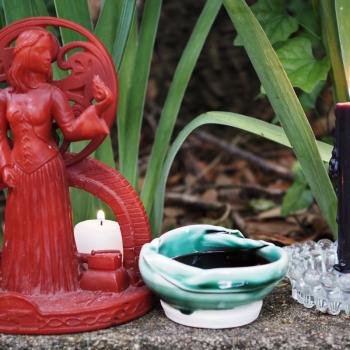Midsummer (or Litha, Sonnenwende, Sankthansaften, Midsommardagen, etc.), is without a doubt, a day with heavy connections to the sun. For those of us in the Northern Hemisphere, Midsummer is the longest ‘day’ of the year, as the sun appears in the sky for far longer than any other day of the year. In certain places of the Northern hemisphere including parts of Scandinavia, the sun may never fully set, giving locals an eye-witness view to what’s colloquially known as a ‘midnight sun’. As such, it should come as no great surprise that in pre-Christian times, as well as for pagans and Asatru today, the day is marked with celebration honoring the sun itself.
Sunna (or Sol) is described in our tradition as the Goddess who in her chariot drawn by horses guides the sun in its track, as her brother Mani similarly drives the moon coursing through the sky. We have no actual depiction in the archaeological record of Sunna herself, the closest we come is the Trundholm sun chariot from the Nordic Bronze Age (1700 BCE – 500 BCE) found in Denmark, which depicts the sun (not the Goddess) being pulled by a horse drawn chariot, and the wheels of the chariot are clearly in the form of solar crosses, or sunwheels.

From ancient sources going back thousands of years, we have two types of sunwheels present in the archaeological record. The first is known as a solar cross, which is a circle bisected by a horizontal, and a vertical line arranged in the shape of a cross. The other incorporates the sowilo rune (which literally means ‘sun’) and may be known as a fylfot or swastika (which infamously was misappropriated by the Nazi party in World War II). Variations of this later type of sunwheel can incorporate a varying number of sowilo runes (two or more) into its symmetrical design.
Grimm’s Teutonic Mythology describes the traditional folk practices for Midsummer celebrations in the areas where the Norse Gods were once (and in some cases still are) honored is to set a sunwheel (or a wagon wheel) on fire. In some cases the wheel was simply lit locally and incorporated into the Midsummer bonfire. In other cases people trekked out into the countryside, found a hill, set the sunwheel on fire, and let it roll down the hill as they chased after it, people watching and cheering as they watched it roll along it’s fiery way, as vegetation caught fire. Sometimes mini-fires were set in the fields, as a way of directly burning in offering the crops that the sun had helped to grow, or fragrant herbs were tossed into local bonfires instead.
For Litha, I made my very own sunwheel to adorn the altar, which was infused with fragrant herbs and flowers. I opted to make my sunwheel in the solar cross design, and began by going to my local crafts store where I purchased a natural straw wreath, as well as natural raffia. Additionally, I stopped off at the florist and picked up sunflowers, yellow roses, purple mums, and a few other odds and ends that seemed appropriate. Then I used the raffia, and wrapped the wreath with it creating my base solar cross design. Once I had made the solar cross , I then began incorporating the flowers into the sunwheel. The end result only decorated the altar for a few brief hours before it was tossed into the Litha bonfire in offering to Sunna herself.
This is an easy project that anyone can do for a modest investment, and can be made both by individuals for their own private rituals or by groups of people as a joint and collective offering. This crafty little project can also serve as a great way of including children into the Litha celebrations.
Midsummer Prayer
Hail Sunna Daughter of Mundilfari the time-turner, Sister of light-gleaming Mani, Wife of Glenr, and fair mother, We hail you.Day-Star, Light-Bringer, Elf-Beam, Ever-glow, All-bright, fair-wheel, Year-counter We greet you.
Shining grace bestow upon us, Healing hands lay upon us, Blessings of warmth, joy and plenty We ask of you.
Hail to thee Sunna, Dancing Fire of Sky and Air, Lady of the Midnight Sun, Golden, ever-Shining One. We Hail!
This article was originally printed in Galina Krasskova’s compiled devotional to Sunna and Mani:
Day Star and Whirling Wheel: Honoring the Sun and the Moon in the Northern Tradition.
















